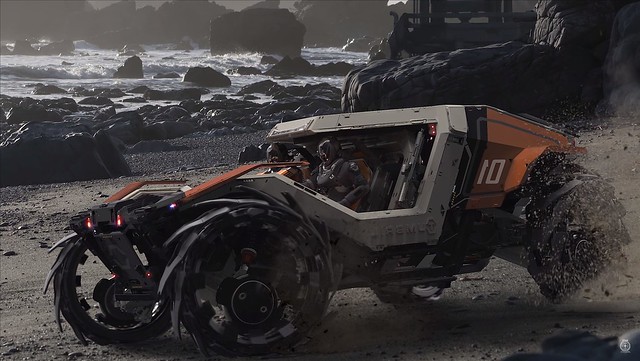The latest Around the Verse video was made public, featuring a look at the various progress being made on Star Citizen. We get to see more of the new Tumbril Cyclone (although no actual gameplay footage of it was showcased), along with a detailed explanation of the new persistent scripting algorithm that allows for some very unique and emergent gameplay possibilities.
The newest Around the Verse is quite lengthy, but well worth the watch if you were interested in getting a good understanding of how entity attachments work in open-world, persistent multiplayer games, as well as how the engineering coincides with making sure that player spawns, ship spawns, and individual player interactions all work cohesively in the persistent universe. Check it out below.
The Austin studio has been working on the PU stations and optimizing itemization at shops around the universe. Ships have also been implemented into the price fixing tool in order to balance the ship respawn time, part prices, and other details that determine how the prices fluctuate in the persistent universe.
The Austin studio has mostly been working on a lot of under-the-hood optimizations that will extend beyond 3.0. They’ve also been working on blending animations for the NPCs working at shops across the universe, including mixing and matching different dialogue options with various animation sets so that the NPCs don’t just rinse and repeat the same canned animations, but procedurally react and interact with players with different expressions and animations.
The more exciting bits of the video was the revelation of the Tumbril Cyclone, a four-wheeled, off-road vehicle with four-wheel drive and four-wheel steering. It has a bit of a Warthog feel to it from Halo.
The Cyclone comes in a number of variants, including a cargo version of the Cyclone, a turret version (which is very similar to the Warthog), the recon version of the Cyclone has stealth components to avoid being detected by radar, an RC racing version, and an anti-air version that comes with missiles and an EMP blast.
The last segment of the video covers the ship-in-ship mechanic that allows players to store other ships inside larger ships.
It’s explained that in order to create ship-in-ship instancing and spawning, it required a lot of rewrites in the engine, and a lot of complex tracking on the backend in order to make it possible.
Additionally, it’s revealed that alpha 2.6 just does not support ship-in-ship functionality, but alpha 3.0 will.
They created a new parent-child algorithm for the persistent data records so that ships can spawn in with ship-in-ship functionality, making it work similar to how they track data such as cargo, weapons and other entities located on the ship.
There’s also the obvious question of: What happens when someone steals another person’s vehicle and store it in their ship?
Well, they created a new legal and physical ownership tag, so that players can physically steal another vehicle from a player, but they won’t legally own it. This could create some really unique possibilities within the persistent universe.
They also built a whole host of persistent tracking so that players can perform some grand theft auto in space, and pirates, for instance, could come in and kill you and take your ship and all the cargo on it and sell it off somewhere.
This kind of persistent element to Star Citizen is a very interesting element that could drastically change the way the game plays.
However… the theft of items adds to the game’s moral factor, specifically the criminal factor. If you steal other player’s ships you will be labeled as a criminal and it will make it tough to get things done in the world when you have a bounty on you or you’re always wanted.
The moral factor and persistent changes are all designed to give Star Citizen an unscripted emergent factor based on player behavior and play-choices.
RSI and CIG plan on demonstrating Star Citizen at this year’s GamesCom, but it’s tough to tell if how far out alpha 3.0 is in relation to the GamesCom presentation. I suppose we’ll find out when August gets here.












